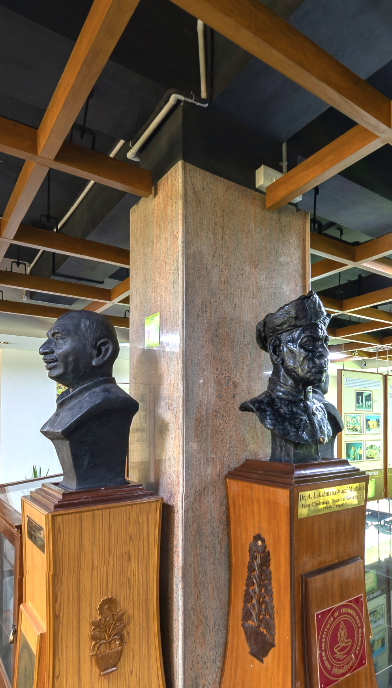The IBM 3215 console terminal and printer being shown to the distinguished guests during the Computer Centre inauguration, 1973

- Photographs , Administrators, Faculty, Inaugurations , 1970s
The device was used to control the operations of the Main Frame (IBM 370/155). Once started, messages were printed on the fan fold pack (a sheet of paper) which would indicate the status of the system. It could print at a speed of 85 characters per second according to a report in The New Indian Express. Computer Operators were trained to work with the device in scheduling programs submitted on punched cards. They were also trained to attend to various devices such as the printer, tape drive and disk packs. Standing from left, Dr. Erhard Eppler (Minister of Economic Co-operation, Federal…
Mr. C. Subramaniam addresses the audience during the inauguration of the Computer Centre, 1973
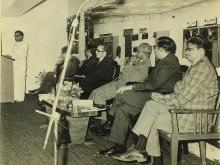
- Photographs , Administrators, Faculty, Inaugurations , 1970s
In the book ‘Computer Education in India: Past, Present and Future’, there is a mention of a report which was published in The Hindu with regard to the Computer Centre inauguration at IIT Madras. It is said that Mr. Subramaniam, in his speech, noted that “the message of science and the marvels of technology should be taken to the common man as part of an attempt to educate and improve his thinking, to change his outlook and to bring about a more rational view of his natural environment and of his own capabilities.” IBM made a large mural specifically for the occasion, using a photograph of…
Mr. C. Subramaniam addressing the audience during the Computer Centre inauguration, 1973
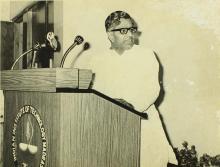
- Photographs , Inaugurations, Visiting VIPs , 1970s
In his speech, Mr. Subramaniam said that “the message of science and the marvels of technology should be taken to the common man as part of an attempt to educate and improve his thinking, to change his outlook and to bring about a more rational view of his natural environment and of his own capabilities.” This was reported in the book ‘Computer Education in India: Past, Present and Future’. Mr. Subramaniam (Union Minister for Industrial Development and Science and Technology) was present during the inauguration of the Computer Centre at IIT Madras on 17 November. He had previously visited…
The IBM 2741 communication terminal at the inauguration of the Computer Centre, 1973
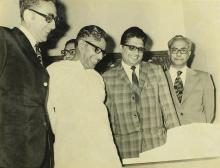
- Photographs , Administrators, Faculty, Inaugurations , 1970s
The IBM 2741 was a printing communication terminal, inspired by the IBM Selectric typewriter. According to Wikipedia, it offered up to 50% higher speed compared to the teletypewriter machines which were used as printing terminals at the time. It also offered top quality printing, interchangeable type fonts and also upper and lower case letters. It also operated without much noise. A news report in The New Indian Express provides details about parts of the 370 computer system. According to the report, there were three typewriter terminals at IIT Madras that could type 15.5 characters per…
A section of the audience during the inauguration of the Computer Centre at IIT Madras, 1973
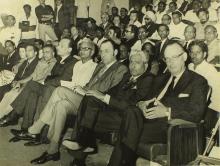
- Photographs , Inaugurations , 1970s
The Institute received the IBM 370/155 system - the largest computing system in Southeast Asia (at the time) as a gift from West Germany in 1973. The system was installed as a regional computer facility for the whole of India and not just IIT Madras. Thousands of students learnt computer programming using the IBM 370 at IIT Madras. Students were able to do their project work using the system, also using it to do computing for the pleasure of it. ‘Computer time’ was allocated in order to prevent crowding at the Computer Centre. Seen in the photograph, Dr. Malcolm Adiseshiah (…
Mr. C. Subramaniam and Prof. H. N. Mahabala, taking a look at the IBM 2741 communication terminal at the inauguration of the Computer Centre, 1973
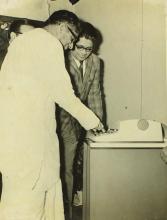
- Photographs , Faculty, Inaugurations, Visiting VIPs , 1970s
The IBM 2741 was a printing communication terminal, inspired by the IBM Selectric typewriter. According to Wikipedia, it offered up to 50% higher speed compared to the teletypewriter machines which were used as printing terminals at the time. It also offered top quality printing, interchangeable type fonts and also upper and lower case letters. It also operated without much noise. A news report in The New Indian Express provides details about parts of the 370 computer system. According to the report, there were three typewriter terminals at IIT Madras that could type 15.5 characters per…
Taking a look at the IBM 3215 console terminal and printer, 1973
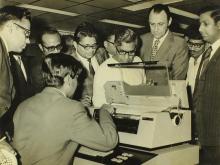
- Photographs , Faculty, Inaugurations, Visiting VIPs , 1970s
The device was used to control the operations of the Main Frame (IBM 370/155). Once started, messages were printed on the fan fold pack (a sheet of paper) which would indicate the status of the system. It could print at a speed of 85 characters per second according to a report in The New Indian Express. Computer Operators were trained to work with the device in scheduling programs submitted on punched cards. They were also trained to attend to various devices such as the printer, tape drive and disk packs. From left, Mr. Srinivasan (IBM), Mr. Kapoor (IBM Systems Engineer, seated),…
Mr. C. Subramaniam taking a look at the 3420/5 Magnetic Tape Subsystem, 1973
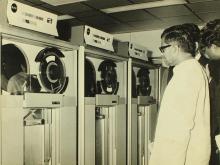
- Photographs , Academic Facilities, Inaugurations, Visiting VIPs , 1970s
This photograph was taken during the Computer Centre inauguration in 1973. IIT Madras had installed the powerful new IBM 370 computer system at the Building Sciences Block this year, opening up new opportunities for researchers and computing enthusiasts. Campaschimes, the coffee table book about IIT Madras, notes that the tape drives were installed in a hall beyond the card readers (where decks of cards containing programs were submitted for further processing). “The code was compiled and processed in the hall beyond the card reader. The activity in this sanctum sanctorum of the…
Prof. K. A. V. Pandalai addresses the audience during the inauguration of the Computer Centre, 1973
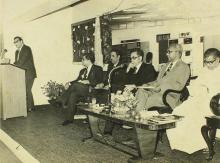
- Photographs , Administrators, Inaugurations, Visiting VIPs , 1970s
According to a report in The Hindu, Prof. Pandalai welcomed the gathering and said that he hoped IIT Madras would become “self-reliant” when German aid would end, and not be reliant on other Institutes or organisations in the future. The Computer Centre was inaugurated on 17 November 1973, around a month and a half after Prof. Pandalai became the Director of the Institute. The previous Director was Prof. A. Ramachandran (also in photograph). Prof. S. Sampath (seated to Prof. Ramachandran’s right hand side) officiated from 11 May 1973 until Prof. Pandalai officially became Director. The…
The IBM 2741 communication terminal at the inauguration of the Computer Centre, 1973
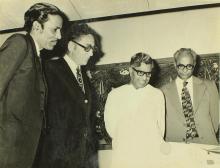
- Photographs , Administrators, Inaugurations, Visiting VIPs , 1970s
The IBM 2741 was a printing communication terminal, inspired by the IBM Selectric typewriter. According to Wikipedia, it offered up to 50% higher speed compared to the teletypewriter machines which were used as printing terminals at the time. It also offered top quality printing, interchangeable type fonts and also upper and lower case letters. It also operated without much noise. A news report in The New Indian Express provides details about parts of the 370 computer system. According to the report, there were three typewriter terminals at IIT Madras that could type 15.5 characters per…
Distinguished guests and some of the IIT Madras faculty at the inauguration of the Computer Centre, 1973
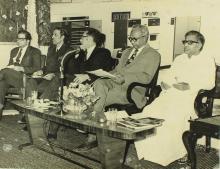
- Photographs , Administrators, Faculty, Inaugurations , 1970s
The Computer Centre was inaugurated at IIT Madras in 1973. The aid of West Germany saw the installation of the IBM 370/155 system at the Institute. The IBM 370 was used by students of IIT Madras. Students would use the system for academic work, as well as to enjoy computing. The computer craze caught up among the students and soon the Institute had to provide quotas for students so that everybody who needed to get their work done could do so without the problem of overcrowding. In order to access the facility, one had to register at the counter of the computer centre at around eight in the…
Inauguration of the Computer Centre at IIT Madras, 1973
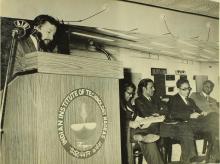
- Photographs , Administrators, Inaugurations, Visiting VIPs , 1970s
IBM made a large mural specifically for the occasion, using a photograph of the IBM 370 taken at the Computer Centre. It was made upon Prof. Mahabala’s request. The mural was placed behind the stage of the Central Lecture Theatre (CLT). In this image, it is visible behind the distinguished guests who are seated at the stage. It was around 25 feet long and approximately 6-8 feet high, providing a clear image of the machine. After the inauguration, the mural was kept in one of the classrooms in the Building Sciences Block (BSB) where M.Tech. classes were held. Seated from left, Prof. S.…
A section of the audience during the inauguration of the Computer Centre at IIT Madras, 1973
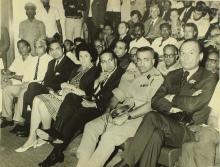
- Photographs , Inaugurations , 1970s
The Institute received the IBM 370/155 system - the largest in India as a gift from West Germany in 1973. Under the Indo-German agreements, of which three had been signed by this time, the West German government agreed to an exchange of faculty and staff between India and West Germany. West Germany also supported IIT Madras in the form of equipment which IIT Madras received over the years. Prior to the installation of the IBM 370, IIT Madras did not have a central computing facility. Individual departments had systems which were not powerful enough for research scholars who were in need of…
The IBM 2741 communication terminal at the inauguration of the Computer Centre, 1973
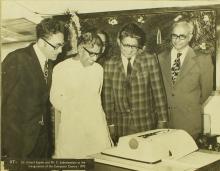
- Photographs , Administrators, Faculty, Inaugurations , 1970s
The IBM 2741 was a printing communication terminal, inspired by the IBM Selectric typewriter. According to Wikipedia, it offered up to 50% higher speed compared to the teletypewriter machines which were used as printing terminals at the time. It also offered top quality printing, interchangeable type fonts and also upper and lower case letters. It also operated without much noise. A news report in The New Indian Express provides details about parts of the 370 computer system. According to the report, there were three typewriter terminals at IIT Madras that could type 15.5 characters per…
Mr. K. T. Chandy addresses the audience during the Computer Centre inauguration, 1973
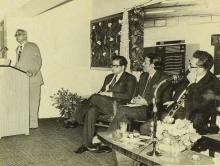
- Photographs , Administrators, Inaugurations, Visiting VIPs , 1970s
In the book ‘Computer Education in India: Past, Present and Future’, there is a brief mention of Mr. Chandy’s speech. According to the book, Mr. Chandy “said the computer centre would function as a focal point for sophisticated research in the South.” Mr. Chandy was the Founder-Director of the first Indian Institute of Management (IIM) in India — IIM Calcutta. He served various positions, as Chairman of Food Corporation of India, Hindustan Steel Limited and Kerala State Industries Development Corporation (KSIDC). During his tenure as Chairman of the Board of Governors at IIT Madras…
- Contribute
to the Centre -
Monetary
Support - Digital
Material

